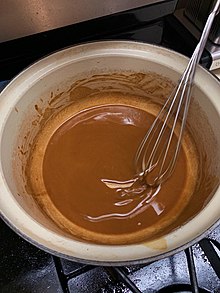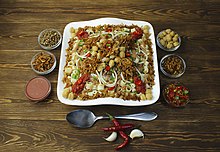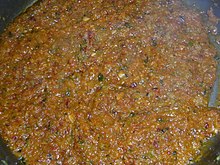Portal:Food
F o o d
A portal dedicated to food and foodways
Introduction


Food is any substance consumed by an organism for nutritional support. Food is usually of plant, animal, or fungal origin and contains essential nutrients such as carbohydrates, fats, proteins, vitamins, or minerals. The substance is ingested by an organism and assimilated by the organism's cells to provide energy, maintain life, or stimulate growth. Different species of animals have different feeding behaviours that satisfy the needs of their metabolisms and have evolved to fill a specific ecological niche within specific geographical contexts.
Omnivorous humans are highly adaptable and have adapted to obtain food in many different ecosystems. Humans generally use cooking to prepare food for consumption. The majority of the food energy required is supplied by the industrial food industry, which produces food through intensive agriculture and distributes it through complex food processing and food distribution systems. This system of conventional agriculture relies heavily on fossil fuels, which means that the food and agricultural systems are one of the major contributors to climate change, accounting for as much as 37% of total greenhouse gas emissions. (Full article...)
Cooking, also known as cookery or professionally as the culinary arts, is the art, science and craft of using heat to make food more palatable, digestible, nutritious, or safe. Cooking techniques and ingredients vary widely, from grilling food over an open fire, to using electric stoves, to baking in various types of ovens, reflecting local conditions. Cooking is an aspect of all human societies and a cultural universal.
Preparing food with heat or fire is an activity unique to humans. Archeological evidence of cooking fires from at least 300,000 years ago exists, but some estimate that humans started cooking up to 2 million years ago.
The expansion of agriculture, commerce, trade, and transportation between civilizations in different regions offered cooks many new ingredients. New inventions and technologies, such as the invention of pottery for holding and boiling of water, expanded cooking techniques. Some modern cooks apply advanced scientific techniques to food preparation to further enhance the flavor of the dish served. (Full article...)

The awarding of a flitch of bacon to married couples who can swear to not having regretted their marriage for a year and a day is an old tradition, the remnants of which still survive in Great Dunmow, Essex.
The Dunmow tradition originated at the nearby Little Dunmow, where it was practiced until the mid-eighteenth century. The origin of the custom is unknown, but according to tradition it was instituted by Robert Fitzwalter in the 13th century. The Dunmow flitch was referred to in Piers Plowman and by Chaucer, and seems to have already been widely-known at that time. A similar tradition practiced at Wychnor in Staffordshire can be traced back to the fourteenth century; related customs are also known from mainland Europe in Brittany and Vienna. (Full article...)
Selected article –
Selected cuisine -

Selected ingredient –
Sofrito (Spanish, Spanish: [soˈfɾito]), sofregit (Catalan, Catalan: [sufɾə'ʒit]), soffritto (Italian, Italian: [sofˈfritto]), or refogado (Portuguese, Portuguese: [ʁɨfuˈɣaðu]), is a basic preparation in Mediterranean, Latin American, Spanish, Italian and Portuguese cooking. It typically consists of aromatic ingredients cut into small pieces and sautéed or braised in cooking oil for a long period of time over a low heat.
In modern Spanish cuisine, sofrito consists of garlic, onion and peppers cooked in olive oil, and optionally tomatoes or carrots. This is known as refogado, sufrito, or sometimes as estrugido in Portuguese-speaking nations, where only garlic, onions, and olive oil are considered essential, tomato and bay laurel leaves being the other most common ingredients. (Full article...)
Selected recipe –

Roux (/ruː/) is a mixture of flour and fat cooked together and used to thicken sauces. Roux is typically made from equal parts of flour and fat by weight. The flour is added to the melted fat or oil on the stove top, blended until smooth, and cooked to the desired level of brownness. A roux can be white, blond (darker) or brown. Butter, bacon drippings or lard are commonly used fats. Roux is used as a thickening agent for gravy, sauces, soups and stews. It provides the base for a dish, and other ingredients are added after the roux is complete. (Full article...)
Vegetable oils are triglycerides extracted from plants. Some of these oils have been part of human culture for millennia. Edible vegetable oils are used in food, both in cooking and as supplements. Many oils, edible and otherwise, are burned as fuel, such as in oil lamps and as a substitute for petroleum-based fuels. Some of the many other uses include wood finishing, oil painting, and skin care.
These oils make up a significant fraction of worldwide edible oil production. All are also used as fuel oils. (Full article...)Selected image –
Selected biography –
B. 28 October 1846 – d. 12 February 1935
Georges Auguste Escoffier (French: [ʒɔʁʒ oɡyst ɛskɔfje]; 28 October 1846 – 12 February 1935) was a French chef, restaurateur, and culinary writer who popularized and updated traditional French cooking methods. Much of Escoffier's technique was based on that of Marie-Antoine Carême, one of the codifiers of French haute cuisine; Escoffier's achievement was to simplify and modernize Carême's elaborate and ornate style. In particular, he codified the recipes for the five mother sauces. Referred to by the French press as roi des cuisiniers et cuisinier des rois ("king of chefs and chef of kings"—also previously said of Carême), Escoffier was a preeminent figure in London and Paris during the 1890s and the early part of the 20th century.
Alongside the recipes, Escoffier elevated the profession. In a time when kitchens were loud, riotous places where drinking on the job was commonplace, Escoffier demanded cleanliness, discipline, and silence from his staff. In bringing order to the kitchen, he tapped into his own military experience to develop the hierarchical brigade de cuisine system for organizing the kitchen staff which is still standard in many restaurants today. He worked in partnership with hotelier César Ritz, rising to prominence together at the Savoy in London serving the elite of society, and later at the Ritz Hotel in Paris and the Carlton in London. (Full article...)
Did you know (auto-generated) –

- ... that the Sonoran blue butterfly uses Dudleya cymosa subsp. pumila as a larval foodplant and hummingbirds feed on its nectar?
- ... that in 1969, the man from Del Monte said yes to Eldorado Electrodata?
- ... that British architect Diane Haigh transformed one historic building into an art gallery and another into a hospice?
- ... that a British supermarket uses barriers to prevent shoppers grabbing food with yellow discount stickers out of the hands of staff?
- ... that not all military rations are food?
- ... that Binggrae, a South Korean food and beverage company, was the official ice cream supplier of the 1988 Seoul Olympics?
More did you know –
Related portals
Food topics
The following are topics relating to food
Categories
Food list articles
- See also: Lists of foods and Category:Lists of drinks
The following are some Food list articles on Wikipedia:

- American cheeses
- Appellation d'Origine Contrôlée cheeses
- Apple cultivars
- Bacon dishes
- Bacon substitutes
- Basil cultivars
- Breads
- Breakfast beverages
- Breakfast cereals
- Breakfast foods
- British cheeses
- Cakes
- Candies
- Cheeses
- Cheese soups
- Christmas dishes (list)
- Cocktails
- Cookies
- Dishes using coconut milk
- Diets
- Doughnut varieties
- Egg dishes
- Fermented soy products
- Food additives
- Food additives (Codex Alimentarius)
- Foods named after people
- French cheeses
- French dishes
- Fried dough foods
- Fruits
- List of hamburgers
- Herbs and spices
- Hors d'oeuvre
- Indian dishes
- Indian snack foods
- Indonesian dishes
- Italian dishes
- Japanese snacks
- Japanese dishes
- Jewish dishes
- Kebabs
- Korean beverages
- Mango cultivars
- Moroccan dishes
- Pasta
- Pastries
- Philippine snack food
- Pies, tarts and flans
- Poppy seed pastries and dishes
- Potato dishes
- Puddings
- Raw fish dishes
- Rice dishes
- Rolled foods
- Sauces
- Seafood
- Seeds
- Sandwiches
- Snack foods
- Soft drinks by country
- Soul foods and dishes
- Soups
- Stews
- Street foods
- Tapas
- Turkish dishes
- Twice-baked foods
- Vegetable oils
- Vegetables
- Vodkas
Things you can do
Related WikiProjects
| Parent project: WikiProject Food and Drink | |
| Child projects: | Task forces: (All inactive) |
|
|
| Related projects: | |
New articles
Rules | Match log | Results page (for watching) | Last updated: 2024-06-06 19:21 (UTC)
Note: The list display can now be customized by each user. See List display personalization for details.
- Sissy Bar (Portland, Oregon) (edit | talk | history | links | watch | logs | tools) by Another Believer (talk · contribs · new pages (90)) started on 2024-06-06, score: 10
- Wunderbar (bar) (edit | talk | history | links | watch | logs | tools) by Brianda (Wiki Ed) (talk · contribs · new pages (4)) started on 2024-06-06, score: 10
- Sammy Haynes (edit | talk | history | links | watch | logs | tools) by Penale52 (talk · contribs · new pages (2)) started on 2024-06-06, score: 10
- Pachira insignis (edit | talk | history | links | watch | logs | tools) by BlakeALee (talk · contribs · new pages (1)) started on 2024-06-06, score: 10
- Biggio's (edit | talk | history | links | watch | logs | tools) by Another Believer (talk · contribs · new pages (90)) started on 2024-06-05, score: 10
- Scallion bread (edit | talk | history | links | watch | logs | tools) by Heeheemalu (talk · contribs · new pages (11)) started on 2024-06-05, score: 30
- Song Jae-jeong (edit | talk | history | links | watch | logs | tools) by Preferwiki (talk · contribs · new pages (4)) started on 2024-06-05, score: 10
- Beryl Shereshewsky (edit | talk | history | links | watch | logs | tools) by Samsmachado (talk · contribs · new pages (5)) started on 2024-06-04, score: 10
- Off the Griddle (edit | talk | history | links | watch | logs | tools) by Another Believer (talk · contribs · new pages (90)) started on 2024-06-04, score: 10
- The Captive of the Sahara (edit | talk | history | links | watch | logs | tools) by Lord Cornwallis (talk · contribs · new pages (37)) started on 2024-06-04, score: 10
- Apple bread (edit | talk | history | links | watch | logs | tools) by Heeheemalu (talk · contribs · new pages (11)) started on 2024-06-04, score: 20
- Chiang Yu-An (edit | talk | history | links | watch | logs | tools) by BemrXDD (talk · contribs · new pages (3)) started on 2024-06-03, score: 10
- John Greene (Nurse) (edit | talk | history | links | watch | logs | tools) by Sue8183 (talk · contribs · new pages (1)) started on 2024-06-03, score: 40
- Red Boat (edit | talk | history | links | watch | logs | tools) by Valereee (talk · contribs · new pages (5)) started on 2024-06-02, score: 10
- Agrosuper (edit | talk | history | links | watch | logs | tools) by FrederickEvans (talk · contribs · new pages (28)) started on 2024-06-02, score: 30
- Fowler Ltd. (edit | talk | history | links | watch | logs | tools) by EssNS (talk · contribs · new pages (27)) started on 2024-06-01, score: 10
- Nilla Wafers (edit | talk | history | links | watch | logs | tools) by Voorts (talk · contribs · new pages (44)) started on 2024-05-26, score: 10
- Solari's (edit | talk | history | links | watch | logs | tools) by Nolabob (talk · contribs · new pages (1)) started on 2024-06-01, score: 20
- Nasi katok (edit | talk | history | links | watch | logs | tools) by The Bangsawan (talk · contribs · new pages (22)) started on 2024-06-01, score: 20
- Justin Sterner (edit | talk | history | links | watch | logs | tools) by Muboshgu (talk · contribs · new pages (12)) started on 2024-05-31, score: 10
- Warankasi (edit | talk | history | links | watch | logs | tools) by Wiisstlo (talk · contribs · new pages (5)) started on 2024-05-26, score: 20
- Brennans Bread (edit | talk | history | links | watch | logs | tools) by Gatepainter (talk · contribs · new pages (3)) started on 2024-05-31, score: 20
- Karin-Lis Svarre (edit | talk | history | links | watch | logs | tools) by Ipigott (talk · contribs · new pages (10)) started on 2024-05-31, score: 10
- Indori poha (edit | talk | history | links | watch | logs | tools) by Apocheir (talk · contribs · new pages (4)) started on 2024-05-30, score: 20
- Tanuki (restaurant) (edit | talk | history | links | watch | logs | tools) by Another Believer (talk · contribs · new pages (90)) started on 2024-05-30, score: 10
- Lena Ice Cream (edit | talk | history | links | watch | logs | tools) by Syazwi Irfan (talk · contribs · new pages (3)) started on 2024-05-23, score: 30
- Ko Myeong-seok (edit | talk | history | links | watch | logs | tools) by Explicit (talk · contribs · new pages (4)) started on 2024-05-30, score: 10
- Savanyúság (edit | talk | history | links | watch | logs | tools) by Konnor Martin (talk · contribs · new pages (1)) started on 2024-05-29, score: 10
- Laal maas (edit | talk | history | links | watch | logs | tools) by SafariScribe (talk · contribs · new pages (153)) started on 2024-05-29, score: 30
- Furrundu (edit | talk | history | links | watch | logs | tools) by BaduFerreira (talk · contribs · new pages (3)) started on 2024-05-29, score: 50
- Hyman's Seafood (edit | talk | history | links | watch | logs | tools) by DMVHistorian (talk · contribs · new pages (4)) started on 2024-05-28, score: 10
- Pickup Coffee (edit | talk | history | links | watch | logs | tools) by Hariboneagle927 (talk · contribs · new pages (25)) started on 2024-05-28, score: 20
- Geoffrey Hawtin (edit | talk | history | links | watch | logs | tools) by Chromista (talk · contribs · new pages (1)) started on 2024-05-28, score: 10
- Palani Panchamirtham (edit | talk | history | links | watch | logs | tools) by Magentic Manifestations (talk · contribs · new pages (14)) started on 2024-05-27, score: 10
- Erismatopterus (edit | talk | history | links | watch | logs | tools) by Kevmin (talk · contribs · new pages (20)) started on 2024-05-27, score: 10
- Saskatoon berry pie (edit | talk | history | links | watch | logs | tools) by Reywas92 (talk · contribs · new pages (4)) started on 2024-05-27, score: 30
- Zus Coffee (edit | talk | history | links | watch | logs | tools) by Hariboneagle927 (talk · contribs · new pages (25)) started on 2024-05-27, score: 20
- Space Cola Wars (edit | talk | history | links | watch | logs | tools) by Artem.G (talk · contribs · new pages (14)) started on 2024-05-27, score: 10
- Conchas de Piedra (edit | talk | history | links | watch | logs | tools) by Another Believer (talk · contribs · new pages (90)) started on 2024-05-27, score: 10
- Torta Balcarce (edit | talk | history | links | watch | logs | tools) by Murmuring Rock (talk · contribs · new pages (4)) started on 2024-05-25, score: 20
- Bilal Yalcinkaya (edit | talk | history | links | watch | logs | tools) by Das osmnezz (talk · contribs · new pages (27)) started on 2024-05-23, score: 10
- Doe Donuts (edit | talk | history | links | watch | logs | tools) by Another Believer (talk · contribs · new pages (90)) started on 2024-05-23, score: 10
Associated Wikimedia
The following Wikimedia Foundation sister projects provide more on this subject:
-
Commons
Free media repository -
Wikibooks
Free textbooks and manuals -
Wikidata
Free knowledge base -
Wikinews
Free-content news -
Wikiquote
Collection of quotations -
Wikisource
Free-content library -
Wikiversity
Free learning tools -
Wiktionary
Dictionary and thesaurus
















































